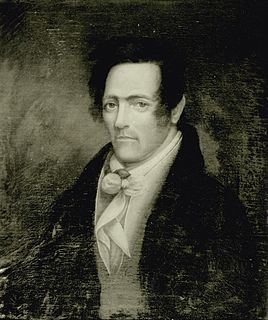Related Research Articles

Philip Hardwick was an English architect, particularly associated with railway stations and warehouses in London and elsewhere. Hardwick is probably best known for London's demolished Euston Arch and its twin station, the original Birmingham Curzon Street, which stands today as the oldest railway terminus building in the world.
The year 1820 in architecture involved some significant events.
The year 1768 in architecture involved some significant events.

Thomas Hamilton was a Scottish architect, based in Edinburgh where he designed many of that city's prominent buildings. Born in Glasgow, his works include: the Burns Monument in Alloway; the Royal High School on the south side of Calton Hill ; the Royal College of Physicians of Edinburgh; the George IV Bridge, which spans the Cowgate; the Dean Orphan Hospital, now the Dean Gallery; the New North Road Free Church, now the Bedlam Theatre; Cumstoun, a private house in Dumfries and Galloway; and the Scottish Political Martyrs' Monument in Old Calton Cemetery, Edinburgh.
Thomas Hardwick (1752–1829) was an English architect and a founding member of the Architects' Club in 1791.

Sir Thomas Slade (1703/4–1771) was an English naval architect, most famous for designing HMS Victory, Lord Nelson's flagship at the Battle of Trafalgar in 1805.
John Pinch was an architect working mainly in the city of Bath, England. He was surveyor to the Pulteney and Darlington estate and responsible for many of the later Georgian buildings in Bath, especially in Bathwick.
George Allen Underwood was an architect in Cheltenham.
Charles Harcourt Masters was an English surveyor and architect in Bath.
Thomas Baldwin was an English architect in the city of Bath, who was responsible for designing some of Bath's principal Georgian buildings.
John Eveleigh was an English surveyor and architect in Bath.
John Lowder was an architect and surveyor working in Bath, Somerset, England. He was the Bath City Surveyor for a short time.

Joshua Barton was the first Missouri Secretary of State. He was involved in three duels with prominent Missouri politicians before being killed in a duel.
John Whichcord Snr (1790–1860) was a British architect who worked in Maidstone, Kent and designed many public and institutional buildings in the town.

The following is a timeline of the history of the city of Bath, Somerset, England.

Thomas Bonnar ( d.1847) was a Scottish interior designer and architect of note, working in the Edinburgh area. He is particularly remembered for his outstanding ceilings.

Thomas Brown was a Scottish architect in the early 19th century based in Edinburgh. He is best known for St. Mary's Church, Bellevue, Edinburgh, usually known as Bellevue Church.

William Jay was an architect. He continued his father's and grandfather's interest in stonemasonry and building design.
References
- ↑ Colvin, Howard (1997). A Biographical Dictionary of British Architects, 1600–1840. New Haven: Yale University Press. ISBN 0-300-07207-4.